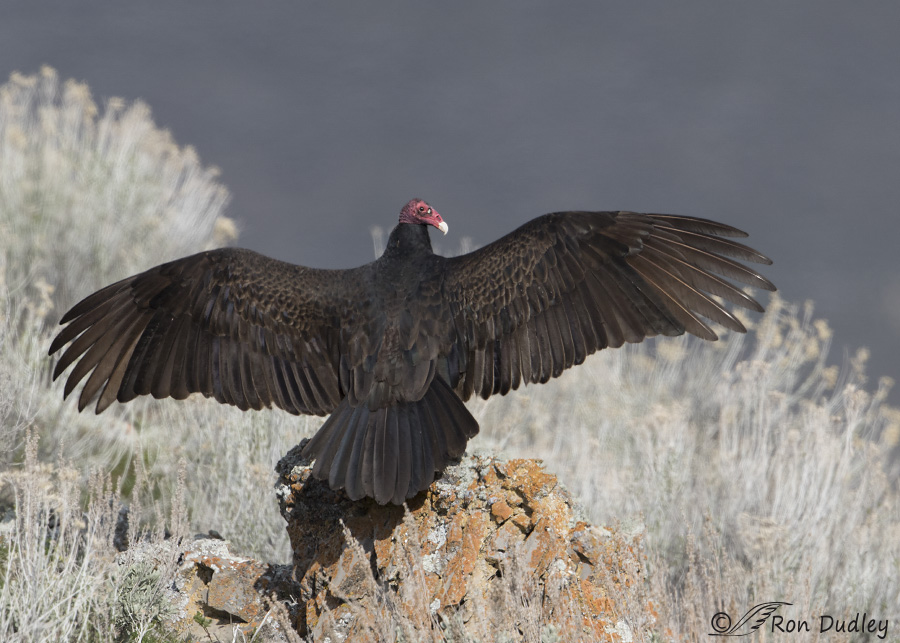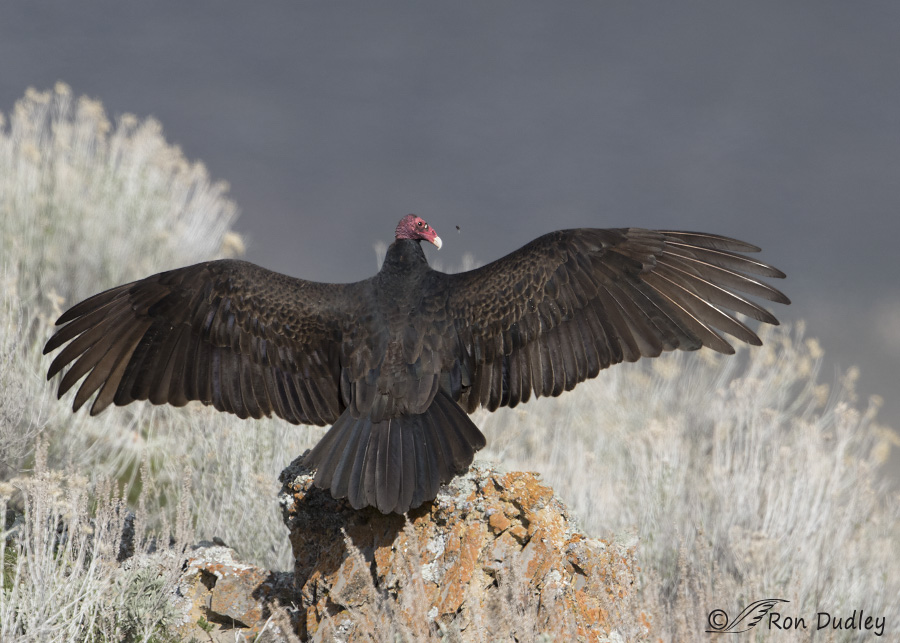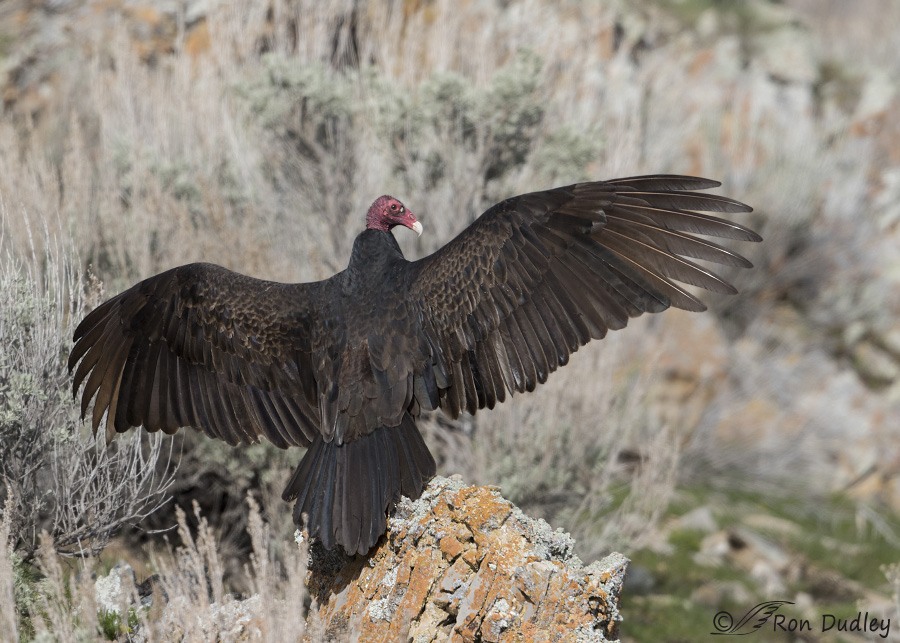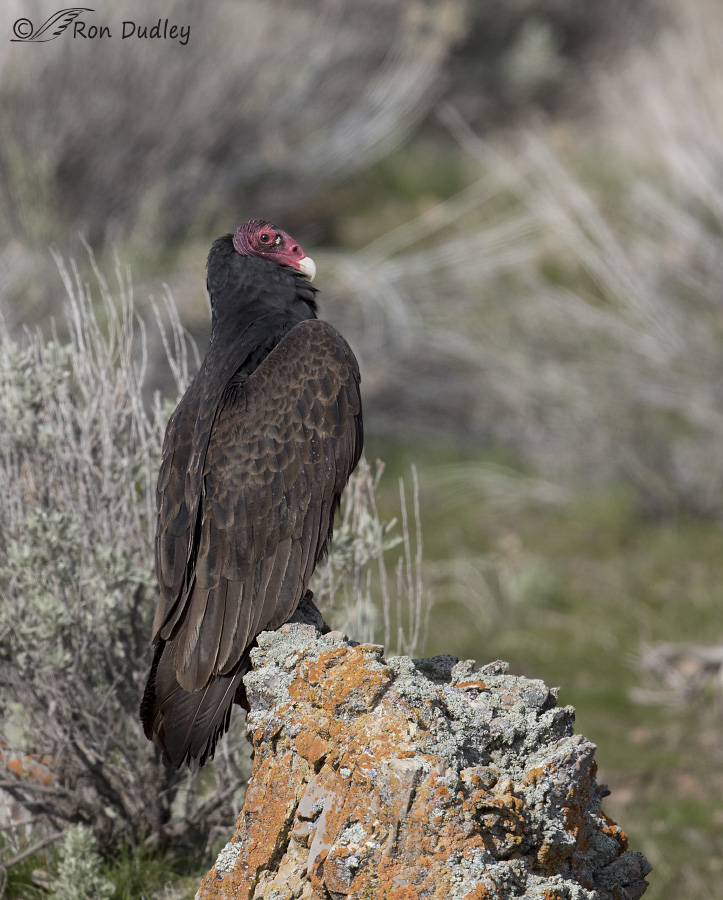Turkey Vultures are well-known for spread-wing posturing. But why do they do it?

1/1250, f/7.1, ISO 400, Canon 7D Mark II, Canon EF 500mm f/4L IS II USM + 1.4 tc, not baited, set up or called in
I photographed this vulture two days ago in Box Elder County, Utah. This pose is usually assumed in full sunlight on morning perches with the dorsal side of the bird facing the sun and they may hold the posture for up to 15 minutes. The behavior likely has several functions in different situations – allowing for heat loss when the bird is too warm, heat gain on cool early mornings and wing drying when the feathers are wet. I’ve also heard it suggested that they may sometimes be using ultraviolet light from the sun to kill bacteria on their plumage from their last decaying meal.

1/2000, f/6.3, ISO 400, Canon 7D Mark II, Canon EF 500mm f/4L IS II USM + 1.4 tc, not baited, set up or called in
I’m including this image just because it amuses me – the vulture is eyeball to eyeball with a flying insect. If you compare the first two images you can see that the bird has turned its head slightly to look directly at the “bug”.

1/3200, f/7.1, ISO 400, Canon 7D Mark II, Canon EF 500mm f/4L IS II USM + 1.4 tc, not baited, set up or called in
Here we see the behavior from a different angle.
Turkey Vultures maintain a lower body temperature at night than in daytime and they likely also use spread-wing posturing in the morning to raise their core body temperature to the daytime level. These images were taken early on a cool morning so I suspect that’s exactly what this bird was doing.
.

1/2500, f/7.1, ISO 400, Canon 7D Mark II, Canon EF 500mm f/4L IS II USM + 1.4 tc, not baited, set up or called in
Here’s a closer look at the bird as I passed it near the road. There were many road-killed rabbits and several dead sheep in the area so I suspect that this bird and its companion (out of frame to the right) won’t go hungry for some time to come.
And they’ll provide us a cleanup service as a bonus.
Ron


Last spring my daughter I were out in the west Utah desert. We were caught in a rain storm and after it passed we saw an old dead tree next to the road with 9 Turkey Vultures as like this in the top of the tree. We assumed they were drying out after the storm.
Such a useful, and much maligned bird.
And that wing span? Incredible, and very beautiful.
It’s a 5′ wingspan, EC. Pretty impressive.
Beautiful pictures Ron. In fact, I have never seen such a beautiful Turkey Buzzard. They are just arriving here. I hope they watch out for those bugs!
Thank you, Jean.
Like the color and texture contrasts in these shots…the spikey, silver vegetation(Rabbitbrush, Sage?)!, softly greening grass, warm, orange lichens and browns of the rock, the deeper, darker colors of the bird with just a touch of red on the head….all very pleasing….
“Rabbitbrush, Sage?”
It’s some of both, Patty.
Great shots Ron!
Charlotte
Thanks, Charlotte.
I was working for an Outward Bound based program for HS kids and on my way to work when I saw my first Turkey Vulture– feeding on roadkill just ahead of me. As it rose, I can still remember my excitement!!! Since then, we see many, now a common sight–rocking and rolling, as they ride the thermals…Not so beautiful in grounded closeups, but incredibly so in the air!!! When I wondered how so many of them could possibly find enough to eat, Jerry Liquori told me that bigger birds, like these, don’t have to eat as often as smaller birds with their higher metabolisms, and can go for longer periods between eating. We see Turkey Vultures and now the smaller, more agressivd Black Vultures.
Patty, I’ve never seen a Black Vulture except maybe as a kid in Arizona. Didn’t know enough to ID it at the time.
Black vultures are expanding their range(s) paying no attention whatsoever to the experts’ maps I’ve always thought they were smaller and prettier than their turkey vulture cousins, but then Alexander besotted me. I might not be impartial on that.
I’ve always thought they were smaller and prettier than their turkey vulture cousins, but then Alexander besotted me. I might not be impartial on that.
Black vultures are newer here, too. They are smaller, darker and tend to be more aggressive than the Turkey Vultures, who can look black but tend to be very dark brown …their tails are different,too.
Turkey vultures have red heads and usually longer, narrower tails…Black vultures have shorter, more fanned tails and grey heads…they are a little smaller then their Turkey vulture cousins…
The black vultures can also be IDed in flight because their wing tips are white as opposed to the gray/white trailing edge of the wings on the turkey vultures that also appears to extend across their bodies.
I was always told that the smaller black vultures aren’t so good at breaking into carcasses, so they have to wait for the turkey vultures to open things up. Not sure if that’s true or not, but that might also explain aggressiveness since they’d have to fight for a place at the table??
Enjoyed these shots Ron. Nice job with the blacks again!
Our Turkey Vultures have returned here last month when the weather warmed. We see them all summer flying over our fields and meadows. They migrate south from here third week in October and were back by the second week in March this year. But, the weather is now so cold it is putting a krimp on migration for a lot of species that should be drifting in the rest of this Month.
Only shots I get of them is when they are flying and those shots are below par.
Thanks for sharing.
Sounds like your vultures come and go about the same time ours do, Dick. Keep working on those flight shots!
Ron, that is another beautiful wing spread. Enjoy all the pictures.
Thank you, Trudy.
I just love vultures. I’ve worked with several, both black and turkey vultures and they can be such characters! There’s a special place in my heart for Alexander, a human imprint black vulture who always wanted to be the star of the show in ed programs–I wasn’t the only one besotted with him. He also courted me for a while, and dare I say it, but he taught me the courtship dance. We got very close for about five years, although I had to learn never to wear sandals around him, or shoes with laces to avoid vulture hickies I really miss that guy!
I really miss that guy!
As for the spread-wing posture, another reason is to activate the chemical processes that turns the oils from their Uropygial gland into Vitamin D. Bruce Brooks, in his book “On the Wing,” gives a nice description of what this is all about. “In many species,” he explains, “the oil that a bird spreads from its preen gland over its feathers contains a chemical that turns into Vitamin D when it is exposed to sunlight. The Vitamin D is then absorbed through the skin or swallowed when the bird preens its feathers.”
Also, let me share a couple of links for the California Condors (a LITTLE off topic, but not far):
The Cornell condor cam went live yesterday, just in time for a hatch! http://tinyurl.com/q9wdn64
Here’s a short video of a California Condor release: http://tinyurl.com/grzjdvy
Ha, “vulture hickies” – that forms an image in my mind!
Interesting about the vitamin D thing. I’d heard that before but had forgotten about it. Thanks for the info and for the links, Laura.
You’re welcome, Ron. Now that the Cornell redtail hawk chat is back up and running, I’ll probably have lots of links and info to share that I’ve squirreled away on my cheat sheets. I’ve got around 150 pages of general and specific stuff Birds are fascinating critters!
Birds are fascinating critters!
Beautiful, Ron. Love the contrast and the bug in the scene. Nice it was holding still for you to make the needed adjustments for the contrast. Know Nat Geo said they warm up that way in the mornings in particular. Didn’t know they lower their body temps at night like hummers can do.
Love the contrast and the bug in the scene. Nice it was holding still for you to make the needed adjustments for the contrast. Know Nat Geo said they warm up that way in the mornings in particular. Didn’t know they lower their body temps at night like hummers can do.
Judy, it was nice that this bird held the pose for a while. I needed the time to get that exposure as right as possible.
Ron: A black bird against a white background, all beautifully exposed. Kowabunga! Very nice.
You noticed! Thanks, Richard.
Yes, this these first three shots were tough exposures but I did do some minor exposure adjustments to the brights in the backgrounds in ACR just to fine tune them a little.